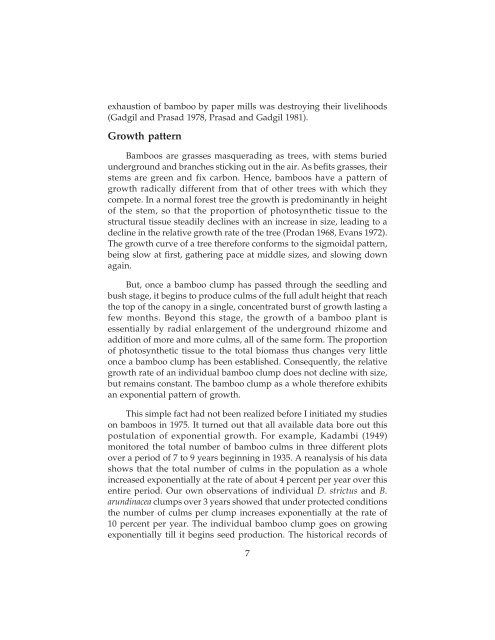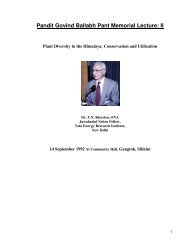Pt. Govind Ballabh Pant Memorial Lecture : XI
Pt. Govind Ballabh Pant Memorial Lecture : XI
Pt. Govind Ballabh Pant Memorial Lecture : XI
- No tags were found...
You also want an ePaper? Increase the reach of your titles
YUMPU automatically turns print PDFs into web optimized ePapers that Google loves.
exhaustion of bamboo by paper mills was destroying their livelihoods(Gadgil and Prasad 1978, Prasad and Gadgil 1981).Growth patternBamboos are grasses masquerading as trees, with stems buriedunderground and branches sticking out in the air. As befits grasses, theirstems are green and fix carbon. Hence, bamboos have a pattern ofgrowth radically different from that of other trees with which theycompete. In a normal forest tree the growth is predominantly in heightof the stem, so that the proportion of photosynthetic tissue to thestructural tissue steadily declines with an increase in size, leading to adecline in the relative growth rate of the tree (Prodan 1968, Evans 1972).The growth curve of a tree therefore conforms to the sigmoidal pattern,being slow at first, gathering pace at middle sizes, and slowing downagain.But, once a bamboo clump has passed through the seedling andbush stage, it begins to produce culms of the full adult height that reachthe top of the canopy in a single, concentrated burst of growth lasting afew months. Beyond this stage, the growth of a bamboo plant isessentially by radial enlargement of the underground rhizome andaddition of more and more culms, all of the same form. The proportionof photosynthetic tissue to the total biomass thus changes very littleonce a bamboo clump has been established. Consequently, the relativegrowth rate of an individual bamboo clump does not decline with size,but remains constant. The bamboo clump as a whole therefore exhibitsan exponential pattern of growth.This simple fact had not been realized before I initiated my studieson bamboos in 1975. It turned out that all available data bore out thispostulation of exponential growth. For example, Kadambi (1949)monitored the total number of bamboo culms in three different plotsover a period of 7 to 9 years beginning in 1935. A reanalysis of his datashows that the total number of culms in the population as a wholeincreased exponentially at the rate of about 4 percent per year over thisentire period. Our own observations of individual D. strictus and B.arundinacea clumps over 3 years showed that under protected conditionsthe number of culms per clump increases exponentially at the rate of10 percent per year. The individual bamboo clump goes on growingexponentially till it begins seed production. The historical records of7











